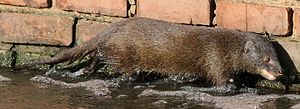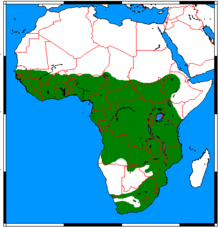Marsh mongoose
| Marsh mongoose | ||||||||||||
|---|---|---|---|---|---|---|---|---|---|---|---|---|

Marsh mongoose ( Atilax paludinosus ) |
||||||||||||
| Systematics | ||||||||||||
|
||||||||||||
| Scientific name of the genus | ||||||||||||
| Atilax | ||||||||||||
| F. Cuvier , 1826 | ||||||||||||
| Scientific name of the species | ||||||||||||
| Atilax paludinosus | ||||||||||||
| ( F. Cuvier , 1829) |
The marsh mongoose , Wassermanguste or Sumpfichneumon ( Atilax paludinosus ) is an African species of mongoose , which has proven particularly well adapted to aquatic habitats.
features
The marsh mongoose is a fairly large species of mongoose, weighing 2.5 to 4.2 kg and a total length of 80 to 100 cm. The bushy tail accounts for 30 to 40 cm. The long, rough fur is uniformly dark brown, sometimes reddish or almost black, the small round ears lie close to the head. Also characteristic are the short muzzle and the webbed toes, which can also be recognized by their step seals. The brain is relatively large, which is probably due to their good sense of touch, which this mongoose needs when foraging for food.
Distribution area
The marsh mongoose is in Africa widespread south of the Sahara and in many areas still quite common. It is absent in very arid regions such as the Sahel , the Horn of Africa and the arid regions of southern Africa. This is partly due to the persecution by people and their use of the riverside areas in these areas.
Way of life
Although they are sometimes quite far from the water, these mongooses are usually found near rivers, swamps, reed areas and coastal regions. The loner, active at night and at dusk, is a good swimmer who mainly hunts crabs, crabs, frogs, small mammals and fish. Even the remains of larger mammals such as cane rats , rock snakes and blue ducks are regularly found in the little predator's droppings. However, the mongoose might have found them dead and eaten them as carrion. Various invertebrates such as giant globules (genus Sphaerotherium ), reptiles, eggs and fruits are also eaten. By adapting to moist habitats close to the water and by their feeding habits, the mongoose avoids competition from other mongooses. But this brings them closer to the otters' niche . Compared to otters, who mainly eat fish and crabs, mongooses are more opportunistic and a large part of their diet also consists of land animals.
The mongooses' roaming areas are mostly in strips along the banks of the water. They regularly deposit their excrement in certain latrines, which are usually not far from the water. Like many tropical species, mongooses have no set breeding period. The females can give birth to 1 to 3 young several times a year. After 10 to 20 days they open their eyes and after a month they are already eating solid food.
Hazardous situation
The mongoose is classified by the World Conservation Union IUCN in the Red List of Threatened Species as not endangered ("Least Concern").
literature
- Gus Mills & Lex Hes: Mammals of southern Africa , Könemann Verlagsgesellschaft, 1999. ISBN 3-8290-3610-8
- Ronald M. Nowak: Walker's Mammals of the World . Johns Hopkins University Press, 1999 ISBN 0-8018-5789-9
- Chris & Tilde Stuart: Field Guide to the Larger Mammals of Africa . Struik, 2000, ISBN 1-86872-534-0
Web links
- Atilax paludinosus in the endangered Red List species the IUCN 2009. Posted by: Hoffmann, M. & Ray, J., 2008. Retrieved on January 26 of 2010.

